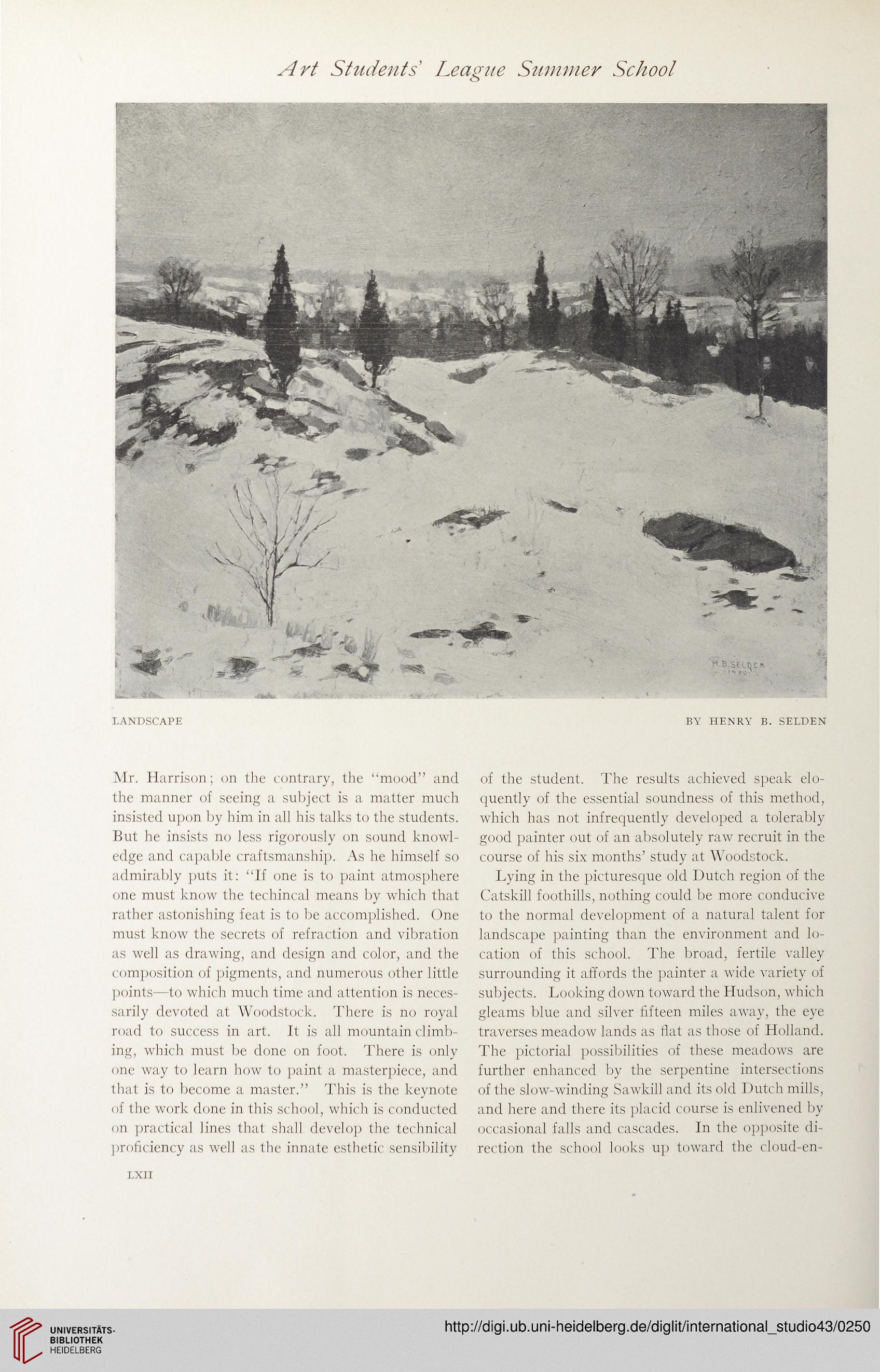Art Students League Summer School
LANDSCAPE BY HENRY B. SELDEN
Mr. Harrison; on the contrary, the “mood” and
the manner of seeing a subject is a matter much
insisted upon by him in all his talks to the students.
But he insists no less rigorously on sound knowl-
edge and capable craftsmanship. As he himself so
admirably puts it: “If one is to paint atmosphere
one must know the techincal means by which that
rather astonishing feat is to be accomplished. One
must know the secrets of refraction and vibration
as well as drawing, and design and color, and the
composition of pigments, and numerous other little
points—to which much time and attention is neces-
sarily devoted at Woodstock. There is no royal
road to success in art. It is all mountain climb-
ing, which must be done on foot. There is only
one way to learn how to paint a masterpiece, and
that is to become a master.” This is the keynote
of the work done in this school, which is conducted
on practical lines that shall develop the technical
proficiency as well as the innate esthetic sensibility
of the student. The results achieved speak elo-
quently of the essential soundness of this method,
which has not infrequently developed a tolerably
good painter out of an absolutely raw recruit in the
course of his six months’ study at Woodstock.
Lying in the picturesque old Dutch region of the
Catskill foothills, nothing could be more conducive
to the normal development of a natural talent for
landscape painting than the environment and lo-
cation of this school. The broad, fertile valley
surrounding it affords the painter a wide variety of
subjects. Looking down toward the Hudson, which
gleams blue and silver fifteen miles away, the eye
traverses meadow lands as flat as those of Holland.
The pictorial possibilities of these meadows are
further enhanced by the serpentine intersections
of the slow-winding Sawkill and its old Dutch mills,
and here and there its placid course is enlivened by
occasional falls and cascades. In the opposite di-
rection the school looks up toward the cloud-en-
LXII
LANDSCAPE BY HENRY B. SELDEN
Mr. Harrison; on the contrary, the “mood” and
the manner of seeing a subject is a matter much
insisted upon by him in all his talks to the students.
But he insists no less rigorously on sound knowl-
edge and capable craftsmanship. As he himself so
admirably puts it: “If one is to paint atmosphere
one must know the techincal means by which that
rather astonishing feat is to be accomplished. One
must know the secrets of refraction and vibration
as well as drawing, and design and color, and the
composition of pigments, and numerous other little
points—to which much time and attention is neces-
sarily devoted at Woodstock. There is no royal
road to success in art. It is all mountain climb-
ing, which must be done on foot. There is only
one way to learn how to paint a masterpiece, and
that is to become a master.” This is the keynote
of the work done in this school, which is conducted
on practical lines that shall develop the technical
proficiency as well as the innate esthetic sensibility
of the student. The results achieved speak elo-
quently of the essential soundness of this method,
which has not infrequently developed a tolerably
good painter out of an absolutely raw recruit in the
course of his six months’ study at Woodstock.
Lying in the picturesque old Dutch region of the
Catskill foothills, nothing could be more conducive
to the normal development of a natural talent for
landscape painting than the environment and lo-
cation of this school. The broad, fertile valley
surrounding it affords the painter a wide variety of
subjects. Looking down toward the Hudson, which
gleams blue and silver fifteen miles away, the eye
traverses meadow lands as flat as those of Holland.
The pictorial possibilities of these meadows are
further enhanced by the serpentine intersections
of the slow-winding Sawkill and its old Dutch mills,
and here and there its placid course is enlivened by
occasional falls and cascades. In the opposite di-
rection the school looks up toward the cloud-en-
LXII





